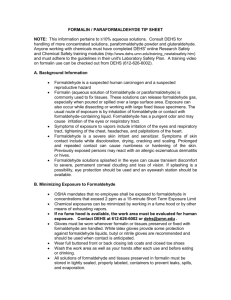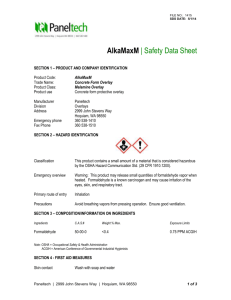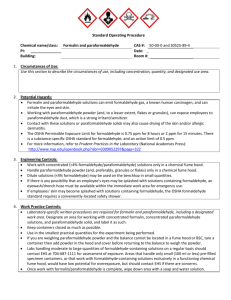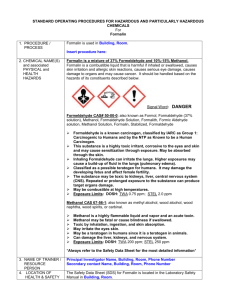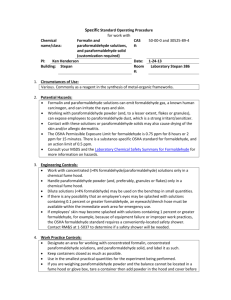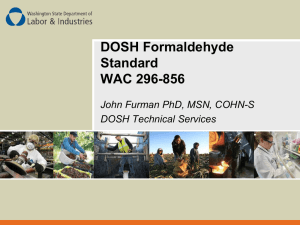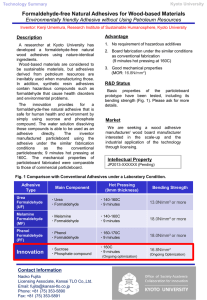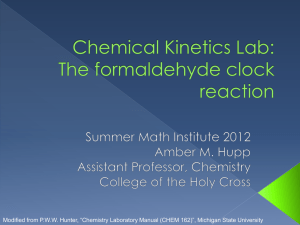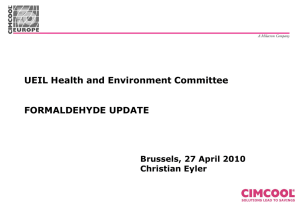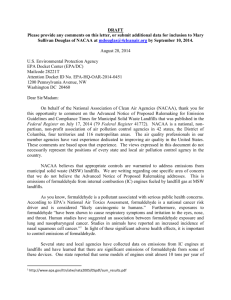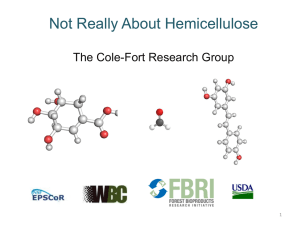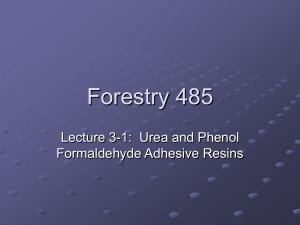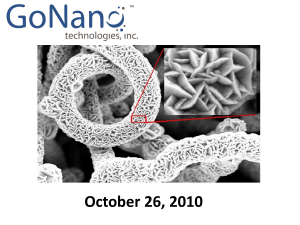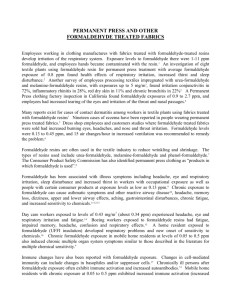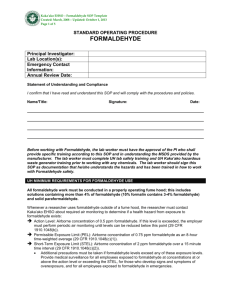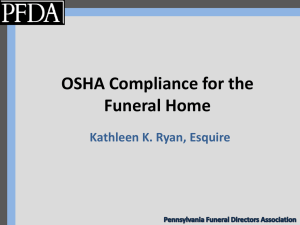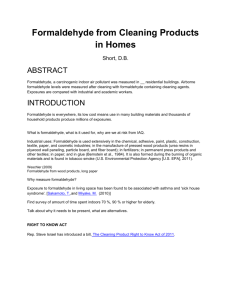Formaldehyde Fact Sheet - the Department of Environmental Health
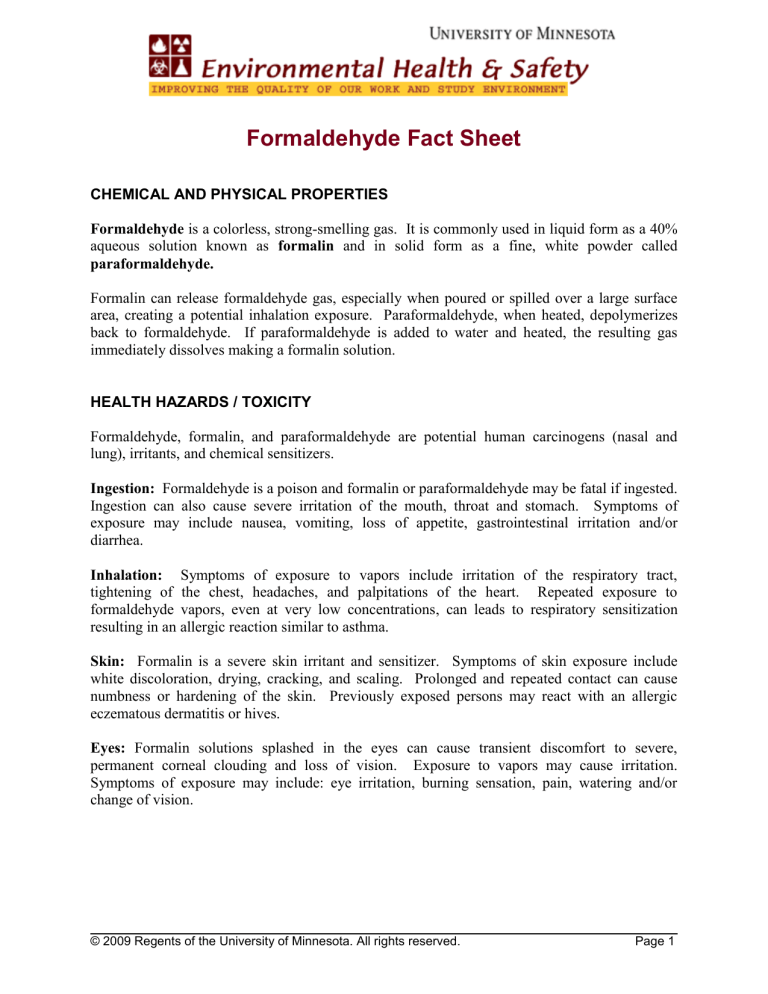
Formaldehyde Fact Sheet
CHEMICAL AND PHYSICAL PROPERTIES
Formaldehyde is a colorless, strong-smelling gas. It is commonly used in liquid form as a 40% aqueous solution known as formalin and in solid form as a fine, white powder called paraformaldehyde.
Formalin can release formaldehyde gas, especially when poured or spilled over a large surface area, creating a potential inhalation exposure. Paraformaldehyde, when heated, depolymerizes back to formaldehyde. If paraformaldehyde is added to water and heated, the resulting gas immediately dissolves making a formalin solution.
HEALTH HAZARDS / TOXICITY
Formaldehyde, formalin, and paraformaldehyde are potential human carcinogens (nasal and lung), irritants, and chemical sensitizers.
Ingestion: Formaldehyde is a poison and formalin or paraformaldehyde may be fatal if ingested.
Ingestion can also cause severe irritation of the mouth, throat and stomach. Symptoms of exposure may include nausea, vomiting, loss of appetite, gastrointestinal irritation and/or diarrhea.
Inhalation: Symptoms of exposure to vapors include irritation of the respiratory tract, tightening of the chest, headaches, and palpitations of the heart. Repeated exposure to formaldehyde vapors, even at very low concentrations, can leads to respiratory sensitization resulting in an allergic reaction similar to asthma.
Skin: Formalin is a severe skin irritant and sensitizer.
Symptoms of skin exposure include white discoloration, drying, cracking, and scaling. Prolonged and repeated contact can cause numbness or hardening of the skin. Previously exposed persons may react with an allergic eczematous dermatitis or hives.
Eyes: Formalin solutions splashed in the eyes can cause transient discomfort to severe, permanent corneal clouding and loss of vision. Exposure to vapors may cause irritation.
Symptoms of exposure may include: eye irritation, burning sensation, pain, watering and/or change of vision.
© 2009 Regents of the University of Minnesota. All rights reserved. Page 1
Department of Environmental Health and Safety – Formaldehyde Fact Sheet
EXPOSURE LIMITS
OSHA instituted the Formaldehyde Standard , 29 CFR 1910.1048, for those potentially exposed to formaldehyde. The OSHA 8-hour permissible exposure limit (PEL) for formaldehyde is 0.75 ppm. The short term exposure limit (STEL) is 2 ppm for a 15-minute period. The odor threshold for formaldehyde is 0.5-1.0 ppm; therefore, if you can smell it you may be above the
PEL.
Researchers exposed to formaldehyde levels of 0.1 ppm or higher must receive annual training.
A training DVD can be checked out from DEHS. Please call (612) 626-6002 to sign out a copy.
SAFE HANDLING AND STORAGE
Labeling: Mixtures and solutions that contain more than 0.1% formaldehyde, or are capable of releasing formaldehyde at concentrations of 0.1 ppm or higher, must have a label indicating that formaldehyde is present. Solutions with more than 0.5% formaldehyde, or solutions that are capable of releasing concentrations of 0.5 ppm or higher, must have warning labels stating that the material has the potential to cause cancer.
Formaldehyde gas is flammable and toxic. Formaldehyde gas cylinders must be stored and used in a ventilated gas cabinet.
Operations involving the pouring, dispensing, or heating of paraformaldehyde or formalin must be carried out in a fume hood or with another form of localized exhaust (e.g., downdraft table).
If no fume hood is available, the work area must be evaluated for human exposure. Contact
DEHS at 612-626-6002 or dehs@umn.edu.
Gloves must be worn whenever paraformaldehyde, formalin or tissues preserved or fixed with formalin are handled. While latex gloves provide some protection against formaldehyde liquids, butyl or nitrile gloves are recommended and should be used when contact is anticipated.
If splashing is a possibility, eye protection must be used and an eyewash station available.
EMERGENCY AND SPILL INFORMATION
Inhalation (Breathing): Remove the victim from the exposure area to fresh air immediately. If breathing has stopped, give artificial respiration. Keep the affected person warm and at rest. If exposure results in a highly irritated upper respiratory tract and coughing continues for more than
10 minutes, the worker should be seen by a medical care provider.
Skin Contact: Remove contaminated clothing (including shoes) immediately. Wash the affected body area with soap or mild detergent and large amounts of water until no evidence of the chemical remains (at least 15 to 20 minutes). If there are chemical burns, get first aid to cover the area with sterile, dry dressing, and bandages. Get medical attention if you experience appreciable eye or respiratory irritation.
© 2009 Regents of the University of Minnesota. All rights reserved. Page 2
Department of Environmental Health and Safety – Formaldehyde Fact Sheet
Eye Contact: Wash the eyes immediately with large amounts of water, occasionally lifting lower and upper lids, until no evidence of chemical remains (at least 15 to 20 minutes). In case of burns, apply sterile bandages loosely without medication. Get medical attention immediately
Spill Information: If formaldehyde is spilled outside a chemical fume hood, evacuate the area, close the laboratory doors, and post the area to prevent others from entering the spill area. From a safe place, call the Department of Environmental Health and Safety (DEHS) (612) 626-6002 during working hours, 911 after hours (Twin Cities Campus 911 operators will contact on-call
DEHS personnel).
REFERENCE
OSHA Formaldehyde Standard (29 CFR 1910.1048) http://www.osha.gov/pls/oshaweb/owadisp.show_document?p_id=10075&p_table=STANDARDS
OSHA Substance Technical Guidelines for Formalin (29 CFR 1910.1048 Appendix A) http://www.osha.gov/pls/oshaweb/owadisp.show_document?p_table=STANDARDS&p_id=10076
© 2009 Regents of the University of Minnesota. All rights reserved. Page 3
